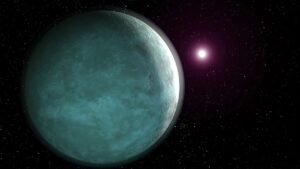
Astronomers have successfully analyzed the atmosphere of WASP-166 b, a hot super-Neptune exoplanet, uncovering the presence of water and carbon dioxide. Utilizing data from the James Webb Space Telescope (JWST), researchers also detected traces of ammonia in smaller quantities. Located about 368 light-years away, WASP-166 b is roughly seven times larger and 32 times heavier than Earth. The planet orbits its host star every 5.44 days at a distance of 0.067 AU, with an equilibrium temperature of 1,270 K, placing it in the “hot Neptune desert.”
JWST Observations and Findings
According to phys.org, JWST utilized its Near Infrared Imager and Slitless Spectrograph (NIRISS) and Near Infrared Camera (NIRCam) to examine WASP-166 b’s atmosphere. The observations identified water and carbon dioxide as key components in the planet’s atmospheric spectrum, with weaker traces of ammonia and cloud deck pressure. The remaining atmosphere is thought to consist of helium and hydrogen in a primordial solar ratio. Searches for carbon monoxide did not yield significant results.
Details on WASP-166 and Its Planet
WASP-166, the host star, is classified as an F9V spectral type, about 20% larger and more massive than the Sun. At 2.1 billion years old, it has a surface temperature of 6,050 K and a metallicity of 0.19 dex. The planetary carbon-to-oxygen ratio of WASP-166 b is 0.282, notably lower than both its host star (0.41) and the Sun (0.55). The planet also has a high atmospheric metallicity of 1.57.
Possible Explanations for Atmospheric Composition
The composition of the atmosphere may be influenced by processes such as planetesimal accretion, core erosion, or photoevaporation. These discoveries offer valuable insights into planetary formation and evolution, especially in the context of the hot Neptune desert. The findings deepen our understanding of exoplanet diversity and their unique features.
